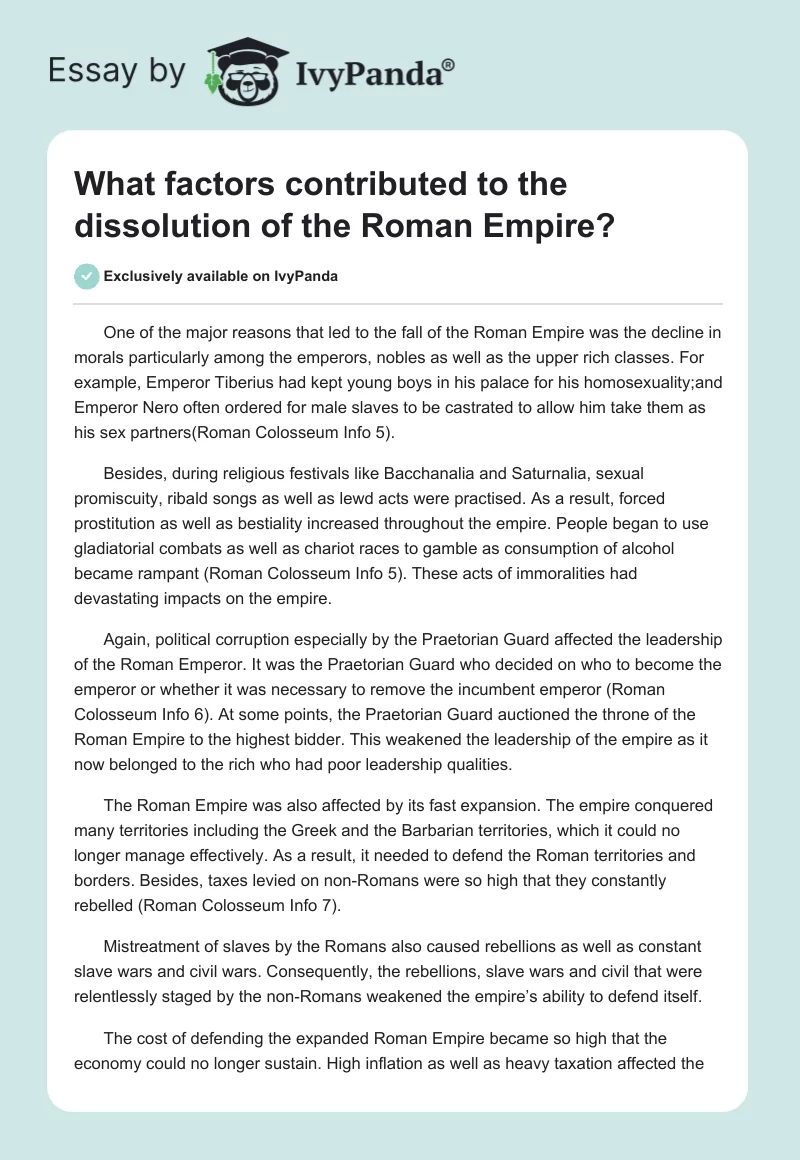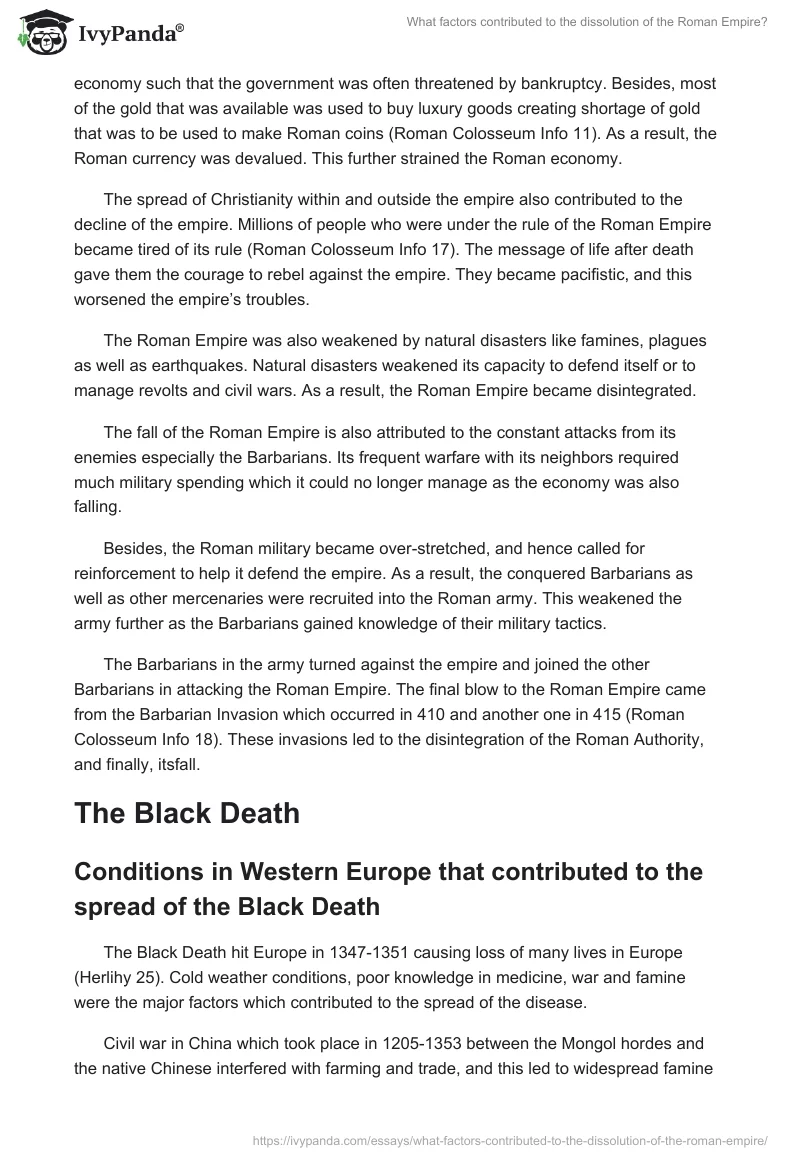One of the major reasons that led to the fall of the Roman Empire was the decline in morals particularly among the emperors, nobles as well as the upper rich classes. For example, Emperor Tiberius had kept young boys in his palace for his homosexuality;and Emperor Nero often ordered for male slaves to be castrated to allow him take them as his sex partners(Roman Colosseum Info 5).
Besides, during religious festivals like Bacchanalia and Saturnalia, sexual promiscuity, ribald songs as well as lewd acts were practised. As a result, forced prostitution as well as bestiality increased throughout the empire. People began to use gladiatorial combats as well as chariot races to gamble as consumption of alcohol became rampant (Roman Colosseum Info 5). These acts of immoralities had devastating impacts on the empire.
Again, political corruption especially by the Praetorian Guard affected the leadership of the Roman Emperor. It was the Praetorian Guard who decided on who to become the emperor or whether it was necessary to remove the incumbent emperor (Roman Colosseum Info 6). At some points, the Praetorian Guard auctioned the throne of the Roman Empire to the highest bidder. This weakened the leadership of the empire as it now belonged to the rich who had poor leadership qualities.
The Roman Empire was also affected by its fast expansion. The empire conquered many territories including the Greek and the Barbarian territories, which it could no longer manage effectively. As a result, it needed to defend the Roman territories and borders. Besides, taxes levied on non-Romans were so high that they constantly rebelled (Roman Colosseum Info 7).
Mistreatment of slaves by the Romans also caused rebellions as well as constant slave wars and civil wars. Consequently, the rebellions, slave wars and civil that were relentlessly staged by the non-Romans weakened the empire’s ability to defend itself.
The cost of defending the expanded Roman Empire became so high that the economy could no longer sustain. High inflation as well as heavy taxation affected the economy such that the government was often threatened by bankruptcy. Besides, most of the gold that was available was used to buy luxury goods creating shortage of gold that was to be used to make Roman coins (Roman Colosseum Info 11). As a result, the Roman currency was devalued. This further strained the Roman economy.
The spread of Christianity within and outside the empire also contributed to the decline of the empire. Millions of people who were under the rule of the Roman Empire became tired of its rule (Roman Colosseum Info 17). The message of life after death gave them the courage to rebel against the empire. They became pacifistic, and this worsened the empire’s troubles.
The Roman Empire was also weakened by natural disasters like famines, plagues as well as earthquakes. Natural disasters weakened its capacity to defend itself or to manage revolts and civil wars. As a result, the Roman Empire became disintegrated.
The fall of the Roman Empire is also attributed to the constant attacks from its enemies especially the Barbarians. Its frequent warfare with its neighbors required much military spending which it could no longer manage as the economy was also falling.
Besides, the Roman military became over-stretched, and hence called for reinforcement to help it defend the empire. As a result, the conquered Barbarians as well as other mercenaries were recruited into the Roman army. This weakened the army further as the Barbarians gained knowledge of their military tactics.
The Barbarians in the army turned against the empire and joined the other Barbarians in attacking the Roman Empire. The final blow to the Roman Empire came from the Barbarian Invasion which occurred in 410 and another one in 415 (Roman Colosseum Info 18). These invasions led to the disintegration of the Roman Authority, and finally, itsfall.
The Black Death
Conditions in Western Europe that contributed to the spread of the Black Death
The Black Death hit Europe in 1347-1351 causing loss of many lives in Europe (Herlihy 25). Cold weather conditions, poor knowledge in medicine, war and famine were the major factors which contributed to the spread of the disease.
Civil war in China which took place in 1205-1353 between the Mongol hordes and the native Chinese interfered with farming and trade, and this led to widespread famine across many regions (Herlihy 25). It is possible that the Mongols who were merchant caravans brought the disease from central Asia to Europe.
The disease was first reported in Trebizond and Constantinople which were trading cities, at around 1347 (Herlihy 26). It was during this time that the Mongol warriors attacked the Genoese possession of Caffa. After a prolonged siege, the Mongol army was reported to be dying from the disease.
The Mongol army decided to use infected corpses to drive the Genoese traders out of the city by capitulating them over the city’s walls. As the traders fled to southern Europe, they transferred the disease to this region where it spread to Western Europe and other parts of Europe.
The extremely cold weather, which was known as “Little Ice Age” that began towards the end of the 13th centuryfueled its spread (Herlihy 27). The cold weather extended into the 14th century and reached its climax in the first half of the century. This weather had severe results across the globe.
A catastrophic famine, known as “the Great Famine”, struck Northern Europe including parts of Western Europe in 1315-1322 (Herlihy 27). Besides, there was no hay, wheat or oats for livestock to feed on. As a result, livestock population diminished causing more hunger and malnutrition. Livestock population was further reduced by anthrax which killed animals in Europe, especially cattle and sheep. This occurred in 1318 causing reduction in food supply as well as income to farmers (Herlihy 27).
Hunger as well as low-level debilitating disease affected the productivity of farmers. This lowered the production of grains. The consequence of the famine was therefore weakened immune system which increased the vulnerability of the population to the disease.
In addition, the governments of Europe did not have the capacity to respond to the epidemic since nobody knew the cause of the disease or even how it spread. The measures that were instituted by the monarchs to control the disease were also ineffective.
Effects of the disease on the social structure
Black Death led to a significant decrease in the continent’s population by about 30-50% (Herlihy 29). However, this increased the social mobility across Western Europe. It created shortage of cheap labor which made landlords to compete for laborers, hence, increasing wages to acquire their services. Thus, the pandemic improved the situation for peasants who survived. Due to the shortage of labor, they had more power since they were in high demand. Besides, there were more available fertile lands for them.
The Black Death weakened the church’s power in Western Europe and the continent as a whole. As a result, the social roles that the church had played before were substituted by secular ones (Herlihy 29). The epidemic also led to peasant revolts across many parts of Europe, particularly in Western Europe. Such included the English Peasant Revolt, the Jacquerie Rebellion in France and the Ciompi Rebellion in Italy (Herlihy 29).
Works Cited
“Causes for the Fall of the Roman Empire.”Roman Colosseum Info. Roman Colosseum Info, 2008. Web.
Herlihy, David. The Black Death and the Transformation of the West. Cambridge, Massachusetts: Harvard University Press, 1997. Print.


